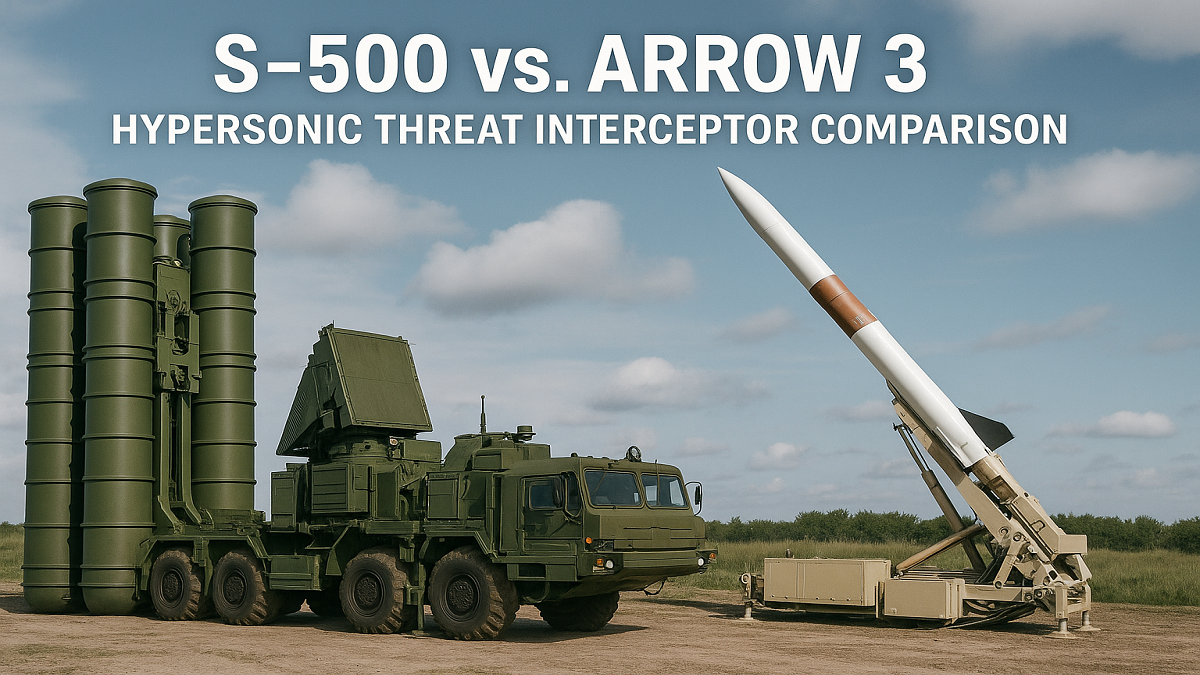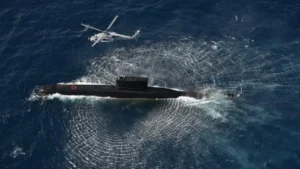As the threat of hypersonic missiles, ballistic warheads, and next-generation aerial threats grows, nations are racing to develop interceptor systems that can detect, track, and destroy targets traveling at extreme speeds and altitudes. Two of the most advanced systems in this arena are Russia’s S-500 Prometey and the Israeli-American Arrow 3 system.
While both aim to counter some of the most dangerous weapons on the battlefield, their design philosophies, operational goals, and technological features differ significantly. This article offers a deep comparative analysis of the S-500 vs Arrow 3, focusing on their capabilities to confront emerging hypersonic and ballistic threats.
1. Introduction: Defending Against Hypersonic and Ballistic Menace
Modern warfare is being reshaped by the emergence of hypersonic glide vehicles (HGVs), maneuverable reentry vehicles (MaRVs), and long-range ballistic missiles. Unlike traditional threats, these weapons move at speeds exceeding Mach 5, with unpredictable flight paths, making them hard to intercept.
Enter the S-500 Prometey and Arrow 3—two elite, high-altitude, anti-ballistic missile systems designed to neutralize advanced missile threats before they reach their targets.
2. S-500 Prometey (Russia)
Overview
The S-500 ‘Prometey’ (Prometheus), developed by Almaz-Antey, is Russia’s next-generation surface-to-air missile (SAM) and anti-ballistic system. It is intended to complement the S-400 Triumf, but with extended capabilities against ballistic missiles, low-orbit satellites, and hypersonic targets.
Key Capabilities
- Target Engagement Range: Up to 600 km for air-breathing targets, 500–600 km for ballistic missiles.
- Altitude Interception: Capable of engaging targets at altitudes of up to 200 km—reaching near-space.
- Interceptors: Incorporates 77N6-N and 77N6-N1 missiles, which can reportedly destroy hypersonic and ICBM-class threats.
- Radar: Multi-band phased array radar system capable of tracking stealth aircraft, low-earth orbit satellites, and multiple targets simultaneously.
- Mobility: Road-mobile, allowing flexible deployment across Russia’s vast territory.
Strategic Role
The S-500 is envisioned as the apex of Russia’s layered air defense, sitting above S-400, Buk, and Pantsir systems. Its mission is to protect strategic assets, military infrastructure, and national command centers from intercontinental ballistic missiles (ICBMs) and hypersonic glide vehicles.
3. Arrow 3 (Israel/USA)
Overview
The Arrow 3 is part of Israel’s multi-tiered missile defense system, developed jointly by Israel Aerospace Industries (IAI) and the U.S. Missile Defense Agency (MDA). Operational since 2017, it is designed to intercept ballistic missiles in space, outside Earth’s atmosphere.
Arrow 3 is specifically tailored to counter threats like Iranian Shahab missiles, future hypersonic weapons, and ICBM-class projectiles.
Key Capabilities
- Target Engagement Range: Estimated at 2,400 km or more, though actual figures are classified.
- Altitude Interception: Exo-atmospheric—intercepts occur in space, at altitudes >100 km.
- Kill Vehicle: Uses a hit-to-kill kinetic interceptor (non-explosive), colliding directly with the target at extreme speeds.
- Radar Integration: Works with the EL/M-2080 Green Pine radar and Super Green Pine, capable of long-range threat detection.
- Mobility: Mobile launch platforms integrated with Israel’s layered defense architecture (with Iron Dome, David’s Sling, and Arrow 2).
Strategic Role
Arrow 3 is designed to provide strategic national defense against long-range missile threats, especially from regional adversaries. It acts as a pre-emptive shield, destroying missiles before they reenter the atmosphere.
4. Technology and Design Philosophy
S-500: Multi-role, Multi-domain
The S-500 is designed as a multi-domain air defense system, combining space defense, ballistic missile interception, and aerial threat neutralization in a single platform. It merges the capability of both SAM systems and ABM systems, allowing it to engage fighter aircraft, UAVs, hypersonic weapons, and even satellites.
The use of solid-fuel interceptors, anti-missile seekers, and multi-band tracking radars puts it among the most versatile air defense systems in the world.
Arrow 3: Pure Space-Based Interception
Arrow 3 focuses entirely on exo-atmospheric interception, using kinetic energy collisions to destroy missiles in the midcourse phase. Its design philosophy is not about versatility, but specialization—offering maximum kill probability against ICBMs before atmospheric reentry.
It is a strategic defense weapon, not intended for tactical use or against aircraft, but for homeland defense against WMD-class ballistic threats.
5. Real-World Deployment and Interoperability
S-500 Status
As of 2024, the S-500 has entered limited service with the Russian Aerospace Forces. Serial production is underway, with planned deployment to Moscow, strategic nuclear facilities, and key military installations. Russia has also discussed export versions, but these would likely be downgraded.
Arrow 3 Status
Arrow 3 is fully operational in Israel and has been exported to Germany as part of Europe’s evolving missile defense posture (notably under the Sky Shield initiative). It is integrated into U.S.-Israel joint defense systems and can link with NATO-compatible radars and command structures.
6. Strengths and Weaknesses
S-500 Prometey
Strengths:
- Can counter multiple threat types: stealth aircraft, hypersonics, ballistic missiles.
- High-altitude engagement near space.
- Fully mobile, with strong battlefield versatility.
Weaknesses:
- Unproven in combat.
- Less specialized in space-only engagements.
- High production cost and limited availability.
Arrow 3
Strengths:
- Exo-atmospheric kill capability against ICBMs.
- Precision hit-to-kill technology reduces debris and collateral risk.
- Operationally tested, backed by U.S. funding and tech.
Weaknesses:
- Designed only for space-based ballistic threats.
- Not suitable for aircraft, cruise missiles, or low-altitude targets.
- Costly, with limited battlefield versatility.



 Indian Navy to Commission INAS 335 (Ospr...
Indian Navy to Commission INAS 335 (Ospr...
 Indian Navy to Commission First Indigeno...
Indian Navy to Commission First Indigeno...
 Rajnath Singh Inaugurates 125 Border Inf...
Rajnath Singh Inaugurates 125 Border Inf...







